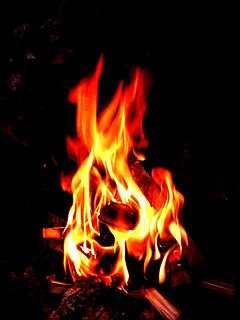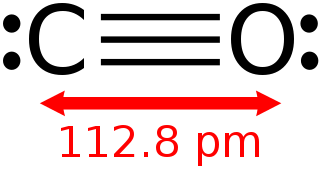
Combustion, or burning, is a high-temperature exothermic redox chemical reaction between a fuel and an oxidant, usually atmospheric oxygen, that produces oxidized, often gaseous products, in a mixture termed as smoke. Combustion does not always result in fire, because a flame is only visible when substances undergoing combustion vaporize, but when it does, a flame is a characteristic indicator of the reaction. While the activation energy must be overcome to initiate combustion, the heat from a flame may provide enough energy to make the reaction self-sustaining.

Carbon monoxide is a colorless, highly poisonous, odorless, tasteless, flammable gas that is slightly less dense than air. Carbon monoxide consists of one carbon atom and one oxygen atom connected by a triple bond. It is the simplest molecule of the oxocarbon family. In coordination complexes the carbon monoxide ligand is called carbonyl. It is a key ingredient in many processes in industrial chemistry.

Redox is a type of chemical reaction in which the oxidation states of substrate change.
The Swern oxidation, named after Daniel Swern, is a chemical reaction whereby a primary or secondary alcohol is oxidized to an aldehyde or ketone using oxalyl chloride, dimethyl sulfoxide (DMSO) and an organic base, such as triethylamine. It is one of the many oxidation reactions commonly referred to as 'activated DMSO' oxidations. The reaction is known for its mild character and wide tolerance of functional groups.
In chemistry, a reducing agent is a chemical species that "donates" an electron to an electron recipient. Examples of substances that are commonly reducing agents include the Earth metals, formic acid, oxalic acid, and sulfite compounds.

A flame is the visible, gaseous part of a fire. It is caused by a highly exothermic chemical reaction taking place in a thin zone. When flames are hot enough to have ionized gaseous components of sufficient density they are then considered plasma.
A reducing atmosphere is an atmospheric condition in which oxidation is prevented by removal of oxygen and other oxidizing gases or vapours, and which may contain actively reducing gases such as hydrogen, carbon monoxide, and gases such as hydrogen sulfide that would be oxidized by any present oxygen. Although early in its history the Earth had a reducing atmosphere, it now instead has an oxidizing atmosphere with molecular oxygen (dioxygen, O2) as the primary oxidizing agent.
The Thermomicrobia is a group of thermophilic green non-sulfur bacteria. Based on species Thermomicrobium roseum and Sphaerobacter thermophilus, this bacteria class has the following description:
Carboxyhemoglobin, or carboxyhaemoglobin, is a stable complex of carbon monoxide and hemoglobin (Hb) that forms in red blood cells upon contact with carbon monoxide. Carboxyhemoglobin is often mistaken for the compound formed by the combination of carbon dioxide (carboxyl) and hemoglobin, which is actually carbaminohemoglobin. Carboxyhemoglobin terminology emerged when carbon monoxide was known by its ancient name carbonic oxide and evolved through Germanic and British English etymological influences; the preferred IUPAC nomenclature is carbonylhemoglobin.
Phosphorus trifluoride (formula PF3), is a colorless and odorless gas. It is highly toxic and reacts slowly with water. Its main use is as a ligand in metal complexes. As a ligand, it parallels carbon monoxide in metal carbonyls, and indeed its toxicity is due to its binding with the iron in blood hemoglobin in a similar way to carbon monoxide.
In taxonomy, Stappia is a genus of the Hyphomicrobiales. Some members of the genus oxidize carbon monoxide (CO) aerobically. Stappia indica is a diatom associated bacterium which is known to inhibit the growth of diatoms such as Thalassiosira pseudonana.
Pseudonocardia is the type genus of the bacteria family Pseudonocardiaceae. Members of this genus have been found living mutualistically on the cuticle of the leafcutter ants because the bacteria has antibiotic properties that protect the fungus grown by the ants. When they are grooming, their legs are passed over their mouth gland that produces the antibiotic and then their legs touch the fungi while they are walking around. The ants have metapleural glands that produce the antimicrobial components to eliminate the Escovopsis fungi. The bacteria may also be found in crypts on the propleural plate. Pseudonocardia is found to have antibiotic properties provided to the leaf-cutter ant to inhibit the growth of Escovopsis, which is a black yeast that parasitizes the leaf-cutter ant. Pseudonocardia can be found in both aquatic and terrestrial ecosystems. Pseudonocardia belongs to the phylum Actinobacteria. Most Actinobacteria grow in soils that are of a neutral pH. Actinobacteria are also important in plant-associated microbial communities are referred to as "free-living." This means that they are not dependent on another organism to live. For example: A non-free-living organism would be a parasite that depends on a host as a food source and a place for shelter. "Free-living" also allows these organisms to require less energy and food for survival. Pseudonocardia is catalase-positive, non-motile, aerobic and a non-acid-fasting bacteria and produces a gram positive reaction. Under the microscope they exhibit branching, rod-shaped organisms.
There are many different strains of Pseudonocardia and a good portion of these strains have been found in China, in soils of the forest, and in Eucalyptus trees of Australia.

In pyrology, flames are affected by the fuel introduced and the oxygen available. A flame with a good oxygen-fuel ratio is called a neutral flame. The color of the flame is semi-transparent purple or blue. This flame is optimal for all intentions, because it does not oxidize or get soot onto surfaces.
Alkalilimnicola is a genus in the phylum Pseudomonadota (Bacteria).
Thermosinus carboxydivorans is an anaerobic, thermophilic, Gram-negative, carbon-monoxide-oxidizing, hydrogenogenic bacterium, the type species of its genus. It is facultatively carboxydotrophic, curved, motile, rod-shaped, with a length of 2.6–3 μm, a width of about 0.5 μm and lateral flagellation. Its type strain is Nor1T.
Thermolithobacteria is a class of rod-shaped Gram-positive bacteria within phylum Bacillota. Species within this class are thermophilic lithotrophs isolated from sediment in Calcite Springs in Yellowstone National Park. Thermolithobacter ferrireducens strain JW/KA-2(T) metabolism consists of the oxidation of hydrogen gas and reduction of ferric oxide to magnetite. Thermolithobacter carboxydivorans strain R1(T) is hydrogenic and oxidizes carbon monoxide.
Thermosinus is a Gram-negative bacteria genus from the family of Acidaminococcaceae. Up to now there is only one species of this genus known.
Pseudonocardia hydrocarbonoxydans is a bacterium from the genus of Pseudonocardia which has been isolated from air contaminant. Pseudonocardia hydrocarbonoxydans can oxidize hydrocarbons.
In electrochemistry, CO stripping is a special process of voltammetry where a monolayer of carbon monoxide already adsorbed on the surface of an electrocatalyst is electrochemically oxidized and thus removed from the surface. A well-known process of this type is CO stripping on Pt/C electrocatalysts in which the electrooxidation peak occurs somewhere between 0.5 to 0.9 V depending on the characteristics and structural properties of the specimen.
Terrabacter carboxydivorans is a species of Gram-positive, nonmotile, non-endospore-forming bacteria. Cells are rod-shaped. It was initially isolated from roadside soil near Yonsei University, Seoul, South Korea during a survey for bacteria with the ability to digest carbon monoxide. The species was first described in 2011, and its name is derived from Latin carboxydum (air) and vorans.




